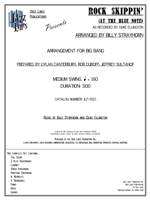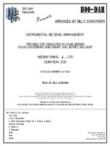ROCK SKIPPIN' (AT THE BLUE NOTE)
Recorded by the Duke Ellington Orchestra
Arranged by Billy Strayhorn, Prepared by Dylan Canterbury, Rob DuBoff, and Jeffrey Sultanof

Cat #: JLP-7615
$65.00This item usually ships within 1 business day.
Questions?
Please call +1-518-587-1102 or email us.
Edition: Jazz Big Band Arrangement
Description: Swing - Medium Difficult
Publisher: Jazz Lines Publications
Written as a tribute to Chicago jazz club owner Frank Holzfiend, Billy Strayhorn and Duke Ellington's "Rock Skippin' (At The Blue Note)" was initially recorded by the Duke Ellington Orchestra in 1951. Played fairly infrequently by the Ellington band after its debut, the song fell into relative obscurity until it was eventually re-recorded by Ellington for the 1967 Strayhorn tribute album "...and his mother called him Bill." This publication has been based on the 1967 version.
The arrangement begins quite simply, with an eight bar plucky piano solo from Ellington leading into the delightfully catchy melody. A trio of trombones handle lead duties during the first two A sections at measure 9, with a playful saxophone riff providing the main accompaniment. The melody is handed off to the woodwinds at measure 19, with Jimmy Hamilton's clarinet gliding over the top of the somewhat dissonant harmonies laid down by the rest of the ensemble. The trombones resume melody duty once more at measure 27, this time with a gentle background figure provided by two trumpets.
The arrangement takes a turn for the bombastic with a rather chaotic ensemble interlude at measure 35. The first four measures feature a bugle-like series of staggered entrances from the trumpets, a descending line from the trombones, and some rhythmic punches from the saxophones battling out for supremacy. Ultimately, however, it is Cootie Williams' plunger muted trumpet solo that wins out, with the ensemble merging together for some dramatic rhythmic hits before handing the spotlight over to Williams for a solo chorus over the entirety of the form at measure 43.
The arrangement begins its slow and gradual wind down at measure 68, returning to the melody's A section which is ultimately repeated four total times. The first time, the trombones play the melody with the saxophones providing the same background riff as they did in the beginning. The saxophones drop out the second time, leaving the trombones to themselves, before the trombones themselves drop out for the third time, leaving the final two repeats for the rhythm section alone. Things come full circle at this point, as Ellington plays a variation on the solo he used to introduce the performance, ultimately fading out to nothing more than one final bass and drum hit.
This arrangement is for jazz big band. With the exception of Ellington's solo introduction and conclusion, this is not a transcription; it has been prepared from the original set of parts and a score compiled for the 1967 session.
2 Alto Saxophones
Clarinet (On Tenor Sax 1)
Tenor Saxophone
Baritone Saxophone
4 Trumpets
3 Trombones
Piano
Bass
Drums
Trombone 1: B4











